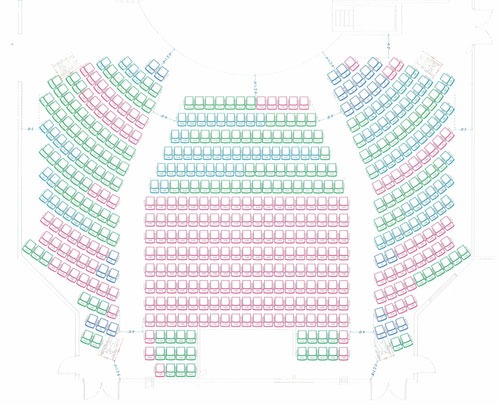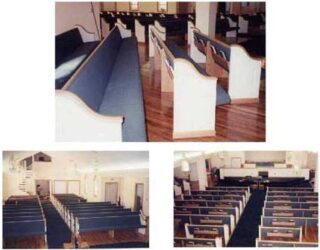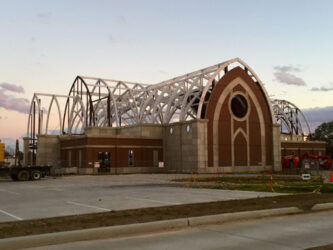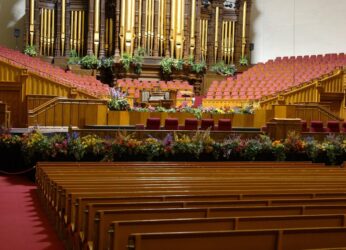There are several seating layout options for auditoriums with multiple aisles. Deciding on what seating to use will depend on the choice of layout, the size and shape of the auditorium, the number of aisles required, and the specific needs of the event or performance. Here are a few common seating arrangements for auditoriums with multiple aisles:
Traditional Theater Style
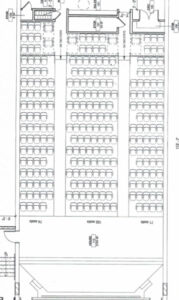 In this layout, the seats are arranged in parallel rows facing the stage or focal point. The aisles run vertically from the front to the back of the auditorium, dividing the seating into sections. This layout is commonly used in theaters and concert halls.
In this layout, the seats are arranged in parallel rows facing the stage or focal point. The aisles run vertically from the front to the back of the auditorium, dividing the seating into sections. This layout is commonly used in theaters and concert halls.
- Rows of seats are arranged in a straight line facing the stage.
- Seats are typically aligned in a sloping or stepped pattern to ensure good visibility for the audience.
- There may be one or more aisles running between sections of seats for ease of access.
- This layout is suitable for performances, lectures, and presentations.
Suitable for performances, lectures, and presentations.
 Semi-Circular or Fan Style
Semi-Circular or Fan Style
- Seats are arranged in a curved or semi-circular pattern, similar to a fan shape.
- A curved seating arrangement gives better sightlines to the centrally located stage.
- This layout allows for a better view of the stage from various angles and provides a more intimate atmosphere.
- It is commonly used for musical performances, small conferences, and presentations.
Multiple Aisle Seating
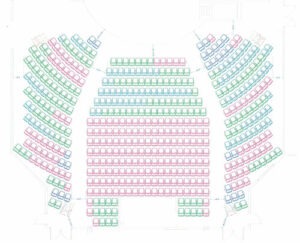 A multiple aisle seating layout refers to a seating arrangement in venues such as theaters, auditoriums, or stadiums where there are multiple aisles dividing the seating sections. This layout is designed to enhance accessibility, crowd management, and overall comfort for the audience. Here are a few common multiple aisle seating layouts:
A multiple aisle seating layout refers to a seating arrangement in venues such as theaters, auditoriums, or stadiums where there are multiple aisles dividing the seating sections. This layout is designed to enhance accessibility, crowd management, and overall comfort for the audience. Here are a few common multiple aisle seating layouts:
- Cross-Aisle Layout: In this layout, two main aisles intersect each other at the center of the seating area, forming a cross shape. This design allows for easy access to all sections of the venue, as each seating block is connected to one of the main aisles.
- Radial Layout: The radial layout features a central stage or focal point, with multiple aisles radiating outwards from it. This configuration is often used in large theaters or arenas, where it allows for a better view of the stage from various angles. Each aisle provides access to several seating sections, ensuring efficient entry and exit paths.
- Grid Layout: The grid layout divides the seating area into a grid-like pattern, with multiple aisles running both horizontally and vertically. This layout is commonly found in larger venues with multiple sections or tiers. It provides balanced access to all seating blocks, with aisles intersecting at regular intervals.
- Staggered Layout: In a staggered layout, the seating sections are staggered. This design helps optimize sightlines and seating capacity, especially in venues where space is limited. Multiple aisles run through the sections, ensuring easy navigation for the audience.
- Semi-Circular Layout: This layout is often seen in amphitheaters or open-air venues. It features a semi-circular arrangement of seating sections, with aisles dividing the sections. The aisles typically radiate from the center stage or performance area, allowing for good visibility and access to all seats.
These are just a few examples of multiple aisle seating layouts, and various combinations and adaptations of these layouts can be implemented based on the specific requirements of the venue and event. The goal is to create a well-organized seating arrangement that offers convenience, optimal views, and efficient crowd management.
Continental Seating
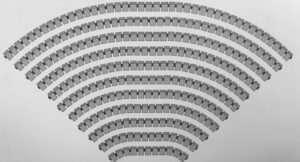 A continental seating layout arranges a large group of seats with aisles on two sides. The rows cannot be more than 49 chairs each aisle. Because of problems with clear passages this seating layout is not as popular.
A continental seating layout arranges a large group of seats with aisles on two sides. The rows cannot be more than 49 chairs each aisle. Because of problems with clear passages this seating layout is not as popular.
Classroom Style
- Long tables or desks are placed in rows, and chairs are positioned behind them.
- This layout is more suitable for educational purposes, such as workshops, seminars, and training sessions.
- It allows attendees to take notes or use laptops and provides a more interactive setting.
Banquet Style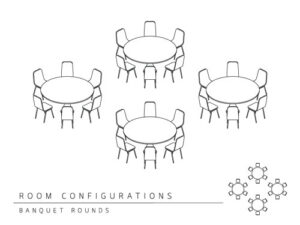
- Round tables are set up with chairs around them.
- This seating arrangement is commonly used for events like dinners, galas, and award ceremonies.
- It encourages social interaction and facilitates conversation among attendees.
Horseshoe or U-Shape Layout
This layout features a semi-circular or horseshoe-shaped arrangement of seats, with multiple aisles dividing the seating into sections. The open end of the horseshoe faces the stage. This layout is often used in lecture halls and conference venues where there is a central stage or presentation area.
In-the-Round Style
- Seats are arranged around a central stage area.
- This layout is often used for performances where the stage is centrally located and the audience surrounds it.
- It provides an immersive experience and allows for a connection between the audience and performers that is more intimate.
Thrust Layout
A thrust layout features seating on three sides of the stage, with multiple aisles dividing the sections. This arrangement provides a more intimate experience, as the audience is closer to the performers. It is commonly used in smaller theaters and performing arts centers.
Telescopic Seating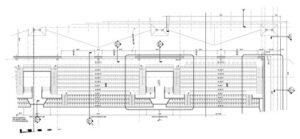
- Retractable Platforms: The seating arrangement typically consists of multiple platforms that can be extended or retracted as needed. These platforms are usually mounted on tracks or wheels, allowing them to move in and out of position.
- Seating Units: On each platform, there are seating units that are securely attached. These units can be rows of individual seats, benches, or bleacher-style seating. The seating units are designed to be comfortable and safe for the audience.
- Motorized System: Telescopic seating systems are usually motorized, allowing for smooth and efficient movement. The platforms can be extended or retracted using a control system, operated by a venue staff member. The motorized system ensures that the seating arrangement can be easily adjusted to accommodate different events and space requirements.
- Flexibility and Configuration: The telescopic seating layout offers great flexibility in terms of configuration. The platforms can be extended fully to provide maximum seating capacity, or they can be partially extended to create aisles or additional space. This flexibility allows for customization based on the specific needs of the event or performance.
- Safety Features: Telescopic seating systems are equipped with safety features to ensure the well-being of the audience. These may include handrails, guardrails, non-slip surfaces, and seat locks to prevent accidental movement when the seating is extended.
- Storage and Compactness: When the seating is retracted, the platforms can be folded or stacked compactly, allowing for efficient storage. This feature is particularly useful in multi-purpose venues where the space needs to be utilized for various purposes.
Overall, telescopic seating layouts provide a practical and adaptable solution for venues that require flexible seating arrangements. The ability to quickly transform a space allows for a seamless transition between different events and maximizes the utilization of the venue’s capacity.
Box or Private Seating
In this layout the seating is divided into private boxes or suites, often located along the sides or balconies of the auditorium. Each box typically has its own entrance, aisles, and seating arrangement. This layout offers a premium and exclusive experience and is commonly found in opera houses and some larger theaters.
These are just a few examples of seating layouts. Depending on the purpose, capacity, and design of the venue, there can be numerous variations and combinations of these styles.



